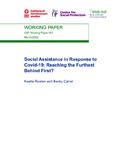Social Assistance in Response to Covid-19: Reaching the Furthest Behind First?
| dc.contributor.author | Roelen, Keetie | |
| dc.contributor.author | Carter, Becky | |
| dc.coverage.spatial | Pakistan | en |
| dc.coverage.spatial | Indonesia | en |
| dc.coverage.spatial | South Africa | en |
| dc.coverage.spatial | Thailand | en |
| dc.coverage.spatial | Vietnam | en |
| dc.coverage.spatial | Mozambique | en |
| dc.coverage.spatial | Peru | en |
| dc.coverage.spatial | Togo | en |
| dc.coverage.spatial | Venezuela | en |
| dc.coverage.spatial | Bangladesh | en |
| dc.coverage.spatial | Ethiopia | en |
| dc.coverage.spatial | Argentina | en |
| dc.coverage.spatial | Democratic Republic of the Congo | en |
| dc.coverage.spatial | Sierra Leone | en |
| dc.coverage.spatial | South Sudan | en |
| dc.coverage.spatial | Sri Lanka | en |
| dc.coverage.spatial | Uganda | en |
| dc.date.accessioned | 2022-03-30T09:33:13Z | |
| dc.date.available | 2022-03-30T09:33:13Z | |
| dc.date.issued | 2022-03-30 | |
| dc.identifier.citation | Roelen, K. and Carter, B. (2022) Social Assistance in Response to Covid-19: Reaching the Furthest Behind First?, Working Paper, Brighton: Institute of Development Studies, DOI: 10.19088/IDS.2022.007 | en |
| dc.identifier.isbn | 978-1-78118-954-2 | |
| dc.identifier.uri | https://opendocs.ids.ac.uk/opendocs/handle/20.500.12413/17274 | |
| dc.description.abstract | Social assistance has proven a vital component of the response to the unprecedented global crisis of Covid-19. Almost all countries across the world implemented some form of social assistance to provide a buffer against the pandemic’s socioeconomic consequences. Vulnerable populations received more extensive support, and groups previously excluded were covered by new or expanded measures. Yet limited information is available about the extent to which social assistance in response to Covid-19 was inclusive of those most marginalised, and whether interventions reached ‘the furthest behind first’. This paper assesses coverage of various vulnerable groups and identifies factors contributing to their in- or exclusion. We find that the rapid and extensive rollout of measures offered support to many vulnerable and marginalised individuals, including those who were not covered prior to the pandemic. Experiences do differ considerably across countries, contexts, and populations with some groups having received heightened attention while others being excluded or finding it difficult to access assistance that they are eligible for. Overall, the degree of inclusiveness of social assistance implemented in the wake of Covid-19 was highly dependent on how inclusive measures were prior to the pandemic. Factors playing into in- or exclusion include availability of data of those most vulnerable; use of digital tools for identification, assessment and payment; identification requirements; employment of social registries; adequacy of vulnerability and targeting criteria; and existence of effective grievance and safeguarding procedures. These findings provide important lessons for how to promote the inclusivity of future social assistance interventions and wider social protection systems. | en |
| dc.description.sponsorship | Irish Aid, Government of Ireland | en |
| dc.description.sponsorship | Centre for Social Protection | en |
| dc.language.iso | en | en |
| dc.publisher | Institute of Development Studies | en |
| dc.relation.ispartofseries | Working Paper; | |
| dc.relation.ispartofseries | CSP Working Paper;021 | |
| dc.rights | This is an Open Access paper distributed under the terms of the Creative Commons Attribution Non Commercial 4.0 International licence (CC BY-NC), which permits use, distribution and reproduction in any medium, provided the original authors and source are credited, any modifications or adaptations are indicated, and the work is not used for commercial purposes. | en |
| dc.rights.uri | http://creativecommons.org/licenses/by-nc/4.0/ | en |
| dc.subject | Aid | en |
| dc.subject | Governance | en |
| dc.subject | Social Protection | en |
| dc.title | Social Assistance in Response to Covid-19: Reaching the Furthest Behind First? | en |
| dc.type | IDS Working Paper | en |
| dc.rights.holder | Institute of Development Studies | en |
| dc.identifier.team | Rural Futures | en |
| dc.identifier.doi | 10.19088/IDS.2022.007 | |
| dcterms.dateAccepted | 2022-03-30 | |
| rioxxterms.funder | Default funder | en |
| rioxxterms.identifier.project | Default project | en |
| rioxxterms.version | VoR | en |
| rioxxterms.versionofrecord | 10.19088/IDS.2022.007 | en |
| rioxxterms.funder.project | 9ce4e4dc-26e9-4d78-96e9-15e4dcac0642 | en |
Files in this item
This item appears in the following Collection(s)
Except where otherwise noted, this item's license is described as This is an Open Access paper distributed under the terms of the Creative Commons Attribution Non Commercial 4.0 International licence (CC BY-NC), which permits use, distribution and reproduction in any medium, provided the original authors and source are credited, any modifications or adaptations are indicated, and the work is not used for commercial purposes.


